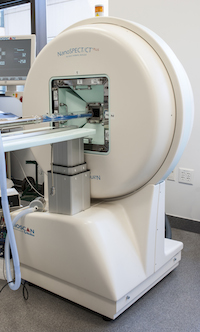BioScan NanoSPECT/CT Plus

Single-photon emission computed tomography (SPECT) is a nuclear medicine tomographic imaging technique using gamma rays. Although similar to conventional nuclear medicine planar imaging using a gamma camera, it provides true 3D information.
Unlike Positron Emission Tomography (PET), which relies on 511 KeV coincidences resulting from positron and electron annihilations, SPECT detects a wide range of gamma rays from 10 KeV to 300 KeV or broader as necessary. Simply put, it provides a “spectrumlike” readout that enables in vivo imaging of multiple biological events or different components of a single injection.
The Small Animal Imaging core facility is equipped with a BioScan NanoSPECT/CT Plus, a dual modality system for imaging mice, rats, and small rabbits. The system is capable of imaging a range of isotopes from the low energy of 125I to 111In, alone or in dual isotope acquisition mode. It is capable of high sensitivity submillimeter imaging, dynamic SPECT, and gated cardiac SPECT imaging.
An optional integrated animal handling system provides a pathogen-free imaging environment.
| SPECT | |
|---|---|
| Resolution | Sub-mm (>0.4 mm); uniform in small volumes 8X better volumetric resolution |
| Sensitivity | Average: 0.3 to 0.4% |
| Axial FOV (FOV) | 2.6 cm (one position) to 27cm (helical scan) |
| Transaxial FOV (TFOV) | Up to 20 cm |
| Suitability | Best for larger proteins, peptides, antibody fragments, hormones |
| Common Isotopes | I-125, Ga-57, Tc-99m, I-123, Lu-177, In-11, I-131 |
| CT | |
| X-ray Source | Standard micro-focus |
| Focal Spot | 5-8 µm |
| Maximum Resolution | 39 µm |
| Capabilities | Cardiac and Respiratory Gating |

